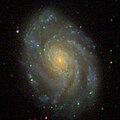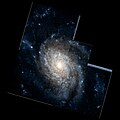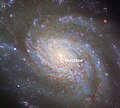NGC 3810
| NGC 3810 | |
|---|---|
 NGC 3810 imaged by the Hubble Space Telescope | |
| Observation data (J2000 epoch) | |
| Constellation | Leo |
| Right ascension | 11h 40m 58.7659s[1] |
| Declination | +11° 28′ 16.371″[1] |
| Redshift | 0.003309[1] |
| Heliocentric radial velocity | 992 ± 1 km/s[1] |
| Distance | 51.2 ± 10.6 Mly (15.7 ± 3.2 Mpc)[1] |
| Apparent magnitude (V) | 10.6[2] |
| Characteristics | |
| Type | SA(rs)c [1] |
| Size | ~64,200 ly (19.67 kpc) (estimated)[1] |
| Apparent size (V) | 4.3′ × 3.0′[2] |
| Other designations | |
| IRAS 11383+1144, UGC 6644, MCG +02-30-010, PGC 36243, CGCG 068-024[1] | |
NGC 3810 is a spiral galaxy located in the constellation Leo. It is about 50 million light years from Earth, and estimated to be about 60,000 light years in diameter. William Herschel discovered it on 15 March 1784.[3]
The bright galaxy NGC 3810 demonstrates spiral structure similar to that of Messier 77. The central part of the galaxy disk is of high surface brightness and features tightly wound spirals. Outside this disk lie more open arms with lower surface brightness.[4] The bright central region is thought to be forming many new stars and is outshining the outer areas of the galaxy by some margin. Further out, the galaxy displays strikingly rich dust clouds along its spiral arms. Hot young blue stars show up in giant clusters far from the centre and the arms are also littered with bright red giant stars.[5]
NGC 3810 forms a small group of galaxies with NGC 3773, the NGC 3810 Group, which is part of the Virgo Supercluster.[6]
Supernovae
Three supernovae have been observed in NGC 3810:
- SN 1997dq (type Ib, mag. 15) was discovered by Masakatsu Aoki on 2 November 1997.[7][8]
- SN 2000ew (type Ic, mag. 14.9) was discovered by Tim Puckett and Alex Langoussis on 28 November 2000.[9][10]
- SN 2022zut (type Ia, mag. 12.8) was discovered by ATLAS on 9 November 2022.[11]
See also
Gallery
- NGC 3810 (SDSS DR14)
- NGC 3810 (HST)
- HST image of NGC 3810, with SN 2022zut marked
References
- ^ a b c d e f g h "NASA/IPAC Extragalactic Database". Results for object NGC 3810. Retrieved 2016-01-18.
- ^ a b "Revised NGC Data for NGC 3810". spider.seds.org. Retrieved 25 November 2018.
- ^ NGC 3810 cseligman.com Celestial Atlas
- ^ Sandage, A., Bedke, J. (1994), The Carnegie Atlas of Galaxies. Volume I, Carnegie Institution of Washington, p. 15
- ^ "NGC 3810: A picture-perfect spiral". www.spacetelescope.org.
- ^ Makarov, Dmitry; Karachentsev, Igor (21 April 2011). "Galaxy groups and clouds in the local (z~ 0.01) Universe". Monthly Notices of the Royal Astronomical Society. 412 (4): 2498–2520. arXiv:1011.6277. Bibcode:2011MNRAS.412.2498M. doi:10.1111/j.1365-2966.2010.18071.x. S2CID 119194025.
- ^ Nakano, S.; Aoki, M.; Jha, S.; Challis, P.; Garnavich, P.; Kirshner, R. (1997). "Supernova 1997dq in NGC 3810". International Astronomical Union Circular (6770): 2. Bibcode:1997IAUC.6770....2N.
- ^ "SN 1997dq". Transient Name Server. IAU. Retrieved 10 December 2024.
- ^ Puckett, T.; Langoussis, A.; Garradd, G. J. (2000). "Supernova 2000ew in NGC 3810". International Astronomical Union Circular (7530): 1. Bibcode:2000IAUC.7530....1P.
- ^ "SN 2000ew". Transient Name Server. IAU. Retrieved 10 December 2024.
- ^ "SN 2022zut". Transient Name Server. IAU. Retrieved 10 December 2024.
External links
 Media related to NGC 3810 at Wikimedia Commons
Media related to NGC 3810 at Wikimedia Commons- NGC 3810 on WikiSky: DSS2, SDSS, GALEX, IRAS, Hydrogen α, X-Ray, Astrophoto, Sky Map, Articles and images



